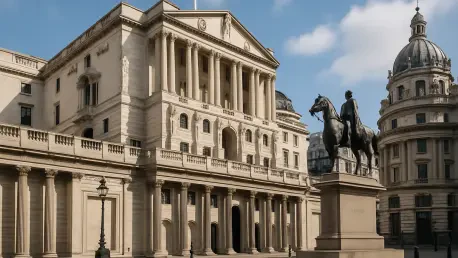I’m thrilled to sit down with Priya Jaiswal, a distinguished expert in banking, business, and finance, whose deep knowledge of market analysis and international trends offers invaluable insights into the complex world of central banking. Today, we’ll explore the intricacies of the Bank of England’s balance sheet reduction, the challenges of quantitative tightening, and the broader implications for financial markets. Our conversation will touch on the hurdles central banks face during this process, the impact of market dynamics on borrowing costs, and how these policies compare across major economies like the U.S. and Europe.
Can you walk us through what the Bank of England means by “bumps in the road” as it shrinks its balance sheet?
Certainly. When the Bank of England talks about “bumps in the road,” they’re referring to unexpected disruptions or volatility in money markets as they reduce their massive holdings of assets, primarily government bonds acquired during years of quantitative easing. These bumps can manifest as sudden spikes in borrowing costs or liquidity shortages, as we’ve seen recently in the gilt repo market. The challenge lies in unwinding a balance sheet that peaked at over 40% of the UK’s annual economic output without destabilizing the financial system. It’s a delicate balancing act—reducing reserves while ensuring banks and markets have enough liquidity to function smoothly.
What specific challenges do you think the Bank of England anticipates in the money markets during this process?
One major challenge is the unpredictability of how banks and financial institutions adjust to lower levels of central bank reserves. As the Bank of England pulls back, there’s a risk of tighter liquidity conditions, which can push up short-term borrowing costs unexpectedly. We’ve already seen this with overnight rates in the gilt repo market jumping significantly. There’s also the issue of timing—month-end reporting or international financial deadlines can exacerbate these pressures, creating temporary but sharp disruptions. The Bank has to monitor these closely to avoid broader impacts on financial stability.
How do these disruptions in the money markets potentially affect everyday banking or the wider economy?
While these bumps often seem like technical issues confined to high finance, they can ripple out. If borrowing costs spike in markets like the gilt repo, it becomes more expensive for banks to access short-term funding. This can lead to tighter credit conditions, meaning loans for businesses or individuals might become costlier or harder to obtain. In extreme cases, if not managed well, these disruptions could undermine confidence in the financial system, though the Bank of England’s liquidity facilities are designed to prevent that by providing a safety net for banks during volatile periods.
Speaking of volatility, there was a notable spike in borrowing costs in the gilt repo market recently. Can you explain what might have triggered that?
Yes, that spike was quite significant—over 30 basis points above the Bank’s base rate, which hadn’t happened in over a decade. Several factors converged to cause this. First, there were large repayments of COVID-era loans by banks, which reduced the amount of cash circulating in the system. Then, you had timing issues like the October month-end, when banks often face increased funding needs for reporting purposes. Additionally, the end of the Canadian financial year played a role, as did some spillover effects from tightness in the U.S. repo market. It was a perfect storm of sorts, but it normalized once banks tapped into the Bank of England’s liquidity tools.
How significant were those spillover effects from the U.S. repo market in contributing to this spike?
The U.S. repo market’s influence was notable but not the primary driver. Global financial markets are deeply interconnected, so when there’s tightness in the U.S.—often due to similar balance sheet reductions by the Federal Reserve—it can create a domino effect. UK banks or institutions with cross-border operations might face higher costs or reduced liquidity as a result. While it wasn’t the main cause of the gilt repo spike, it amplified the pressure already building from domestic factors like loan repayments and month-end dynamics.
Shifting gears, how does the Bank of England’s approach to reducing its balance sheet stack up against the strategies of the U.S. Federal Reserve and the European Central Bank?
All three central banks are engaged in quantitative tightening—reversing the asset purchases made during quantitative easing—but their approaches and challenges vary slightly due to differences in economic contexts. The Bank of England’s balance sheet has shrunk from over 40% to below 25% of GDP, which is broadly in line with the Fed’s trajectory. The ECB, however, has been a bit more cautious due to the fragmented nature of the Eurozone economy. While the overarching goal is the same—normalizing monetary policy after years of stimulus—the Bank of England seems to be moving at a steadier pace, partly because of its reliance on liquidity facilities to cushion market shocks, something the Fed also uses but with different mechanisms.
Are the challenges of quantitative tightening similar across these central banks, or do they face unique hurdles?
There are common challenges, like managing market volatility and ensuring liquidity doesn’t dry up too quickly, but each faces unique hurdles. For the Bank of England, the gilt market’s sensitivity to sudden rate spikes is a key concern, as we’ve seen recently. The Fed deals with a much larger and more complex repo market, plus political pressures around inflation. The ECB has to navigate disparities between stronger and weaker Eurozone economies, which complicates its tightening path. So, while the core issue of unwinding massive balance sheets is shared, the specific pain points differ based on market structures and economic conditions.
Let’s talk about why the Bank of England is reducing its balance sheet in the first place. What was the original purpose of holding such large asset volumes?
The Bank of England, like many central banks, ramped up asset purchases—mainly government bonds—starting in 2009 as part of quantitative easing to support the economy during crises like the financial meltdown and later the pandemic. By buying these bonds, they injected money into the system, kept interest rates low, and encouraged lending and investment. At its peak in 2021, these holdings were over 40% of GDP, an extraordinary level meant to stabilize markets and boost growth during unprecedented uncertainty. It was essentially a way to act as a financial backstop when normal channels weren’t working.
Why is the shift to quantitative tightening happening now, and what does it aim to achieve?
The move to quantitative tightening reflects a belief that the economy no longer needs such heavy intervention. With inflation becoming a bigger concern than deflation in recent years, central banks want to reduce excess liquidity in the system to help control price pressures. By selling off assets or letting them mature without reinvestment, the Bank of England is effectively draining reserves, which can help normalize interest rates and prevent overheating. It’s also about preparing for future crises—having a leaner balance sheet gives them room to act if another downturn hits.
Lastly, what’s your forecast for how the Bank of England’s balance sheet reduction will play out over the next few years, especially with these market bumps in mind?
I think we’ll see a cautious but steady reduction over the next couple of years, with the Bank aiming to bring reserves closer to that preferred minimum range of 375 to 540 billion pounds by late next year or mid-2027, depending on how much banks lean on liquidity facilities. The bumps will continue—spikes in repo rates or other market hiccups are inevitable as the financial system adapts to less central bank support. But the Bank’s tools, like short-term repo operations, should help manage these disruptions, preventing them from threatening broader stability. The bigger question is how inflation and economic growth evolve; if either takes a sharp turn, the pace of tightening could slow to avoid adding stress to an already complex landscape.









